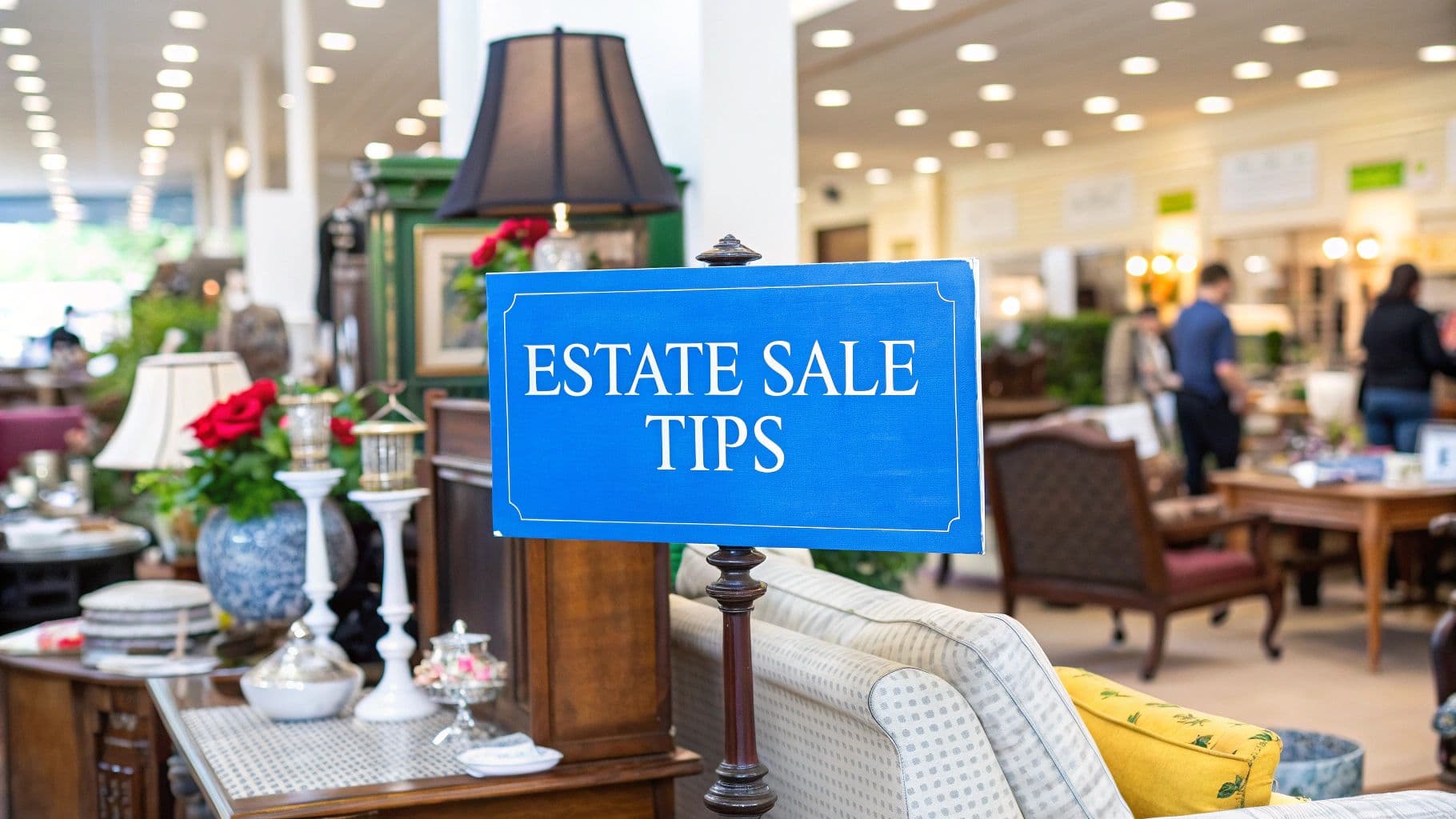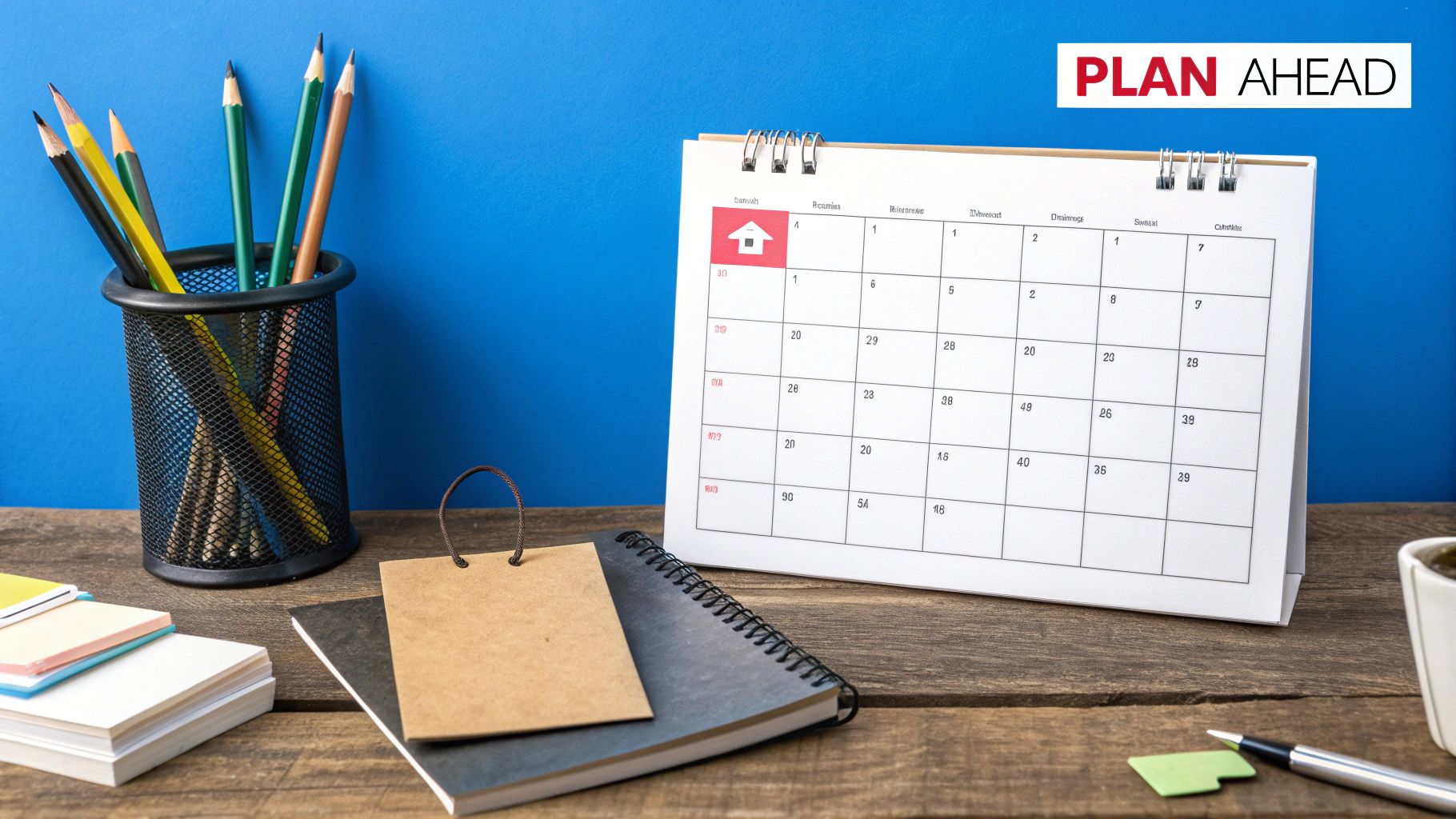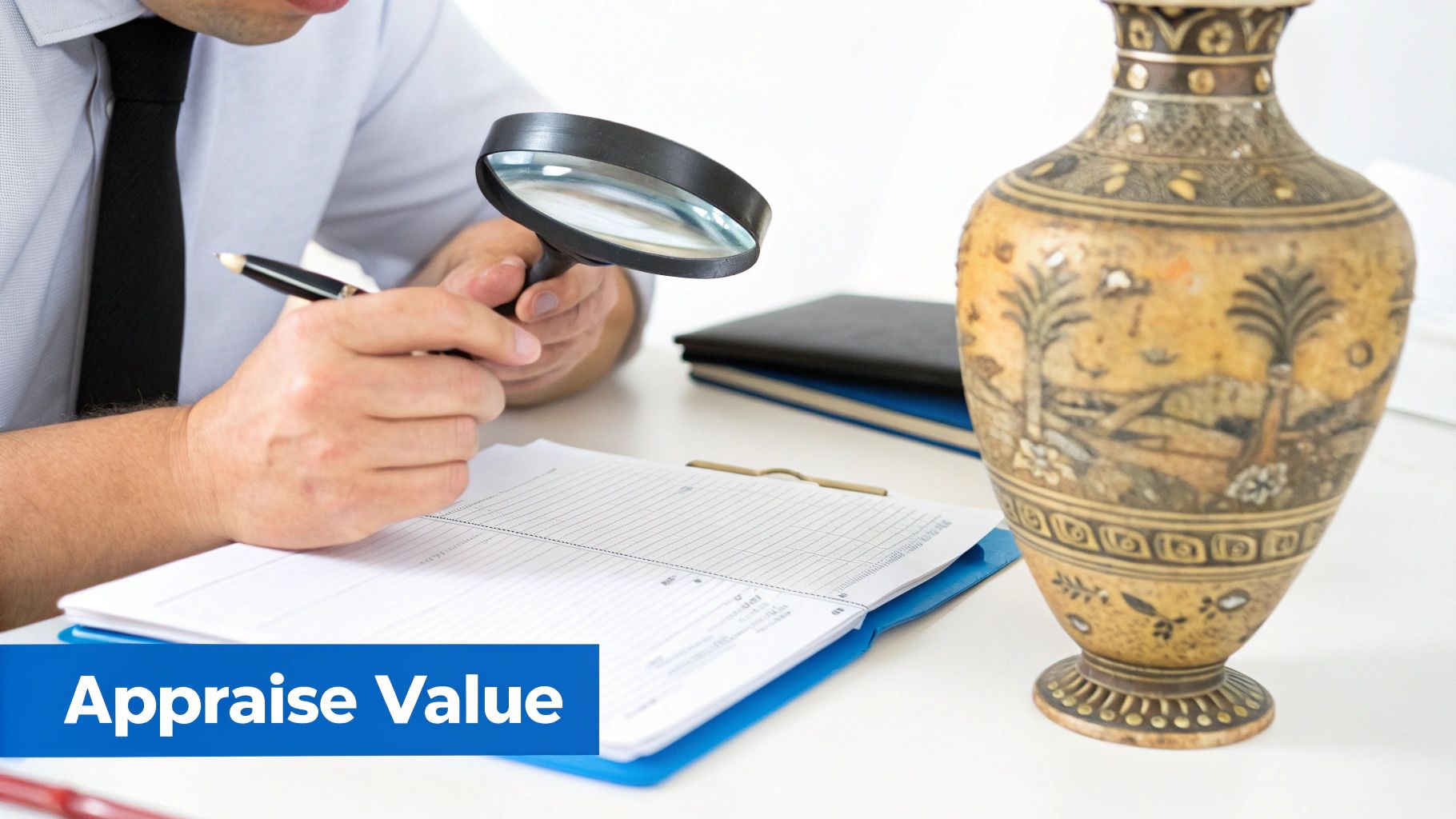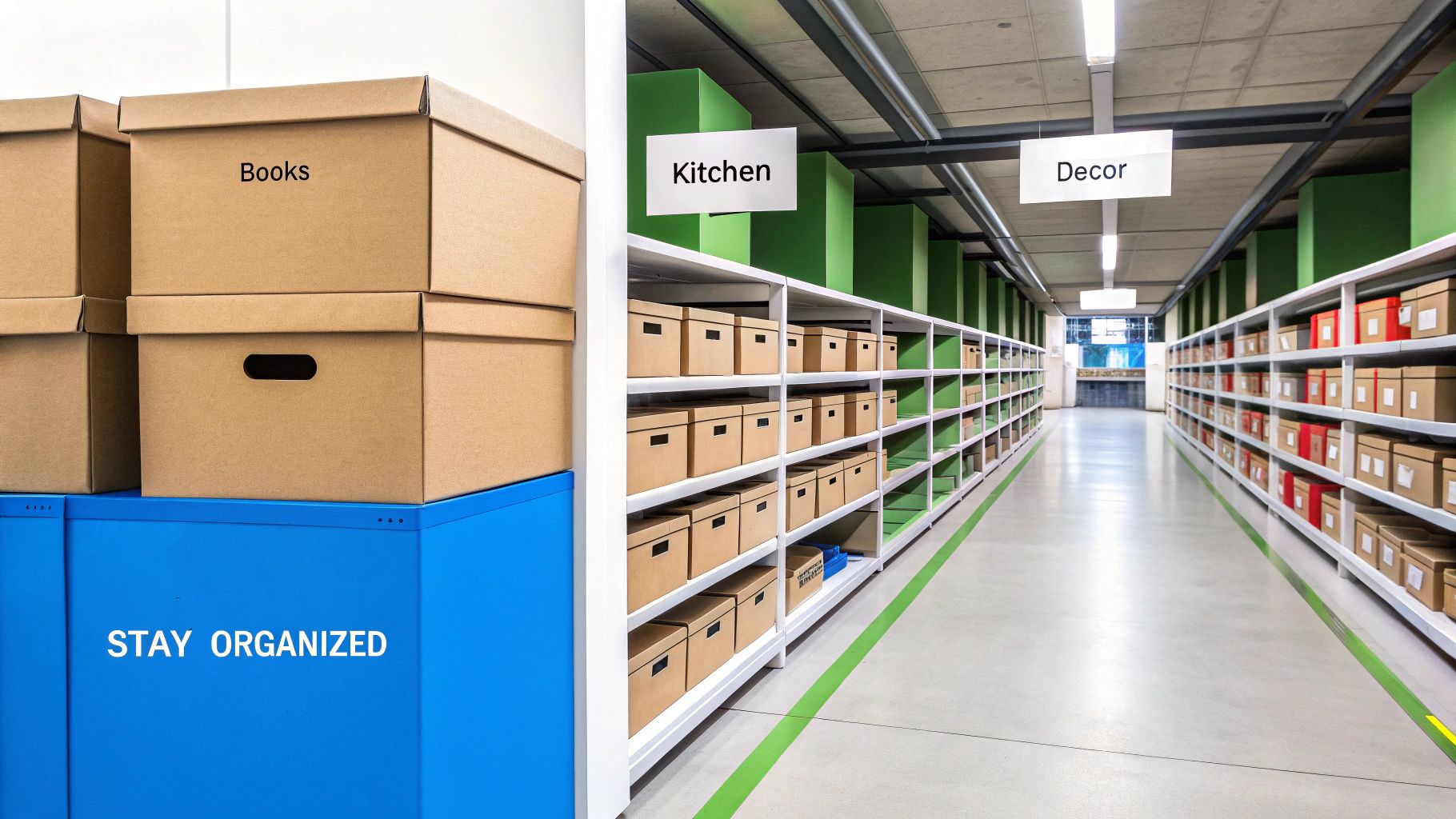8 Essential Estate Sale Tips for Success in 2025

Navigating an estate sale can feel overwhelming, whether you're downsizing, managing an inheritance, or helping a loved one relocate. The goal is always the same: to liquidate assets efficiently, respectfully, and for the highest possible return. Traditional estate sale companies offer a solution, but often at a steep cost, taking 30-50% of your profits. This guide provides a modern alternative.
We'll explore essential, actionable estate sale tips that empower you to take control of the process. By leveraging the right strategies and tools, like the DIYAuctions platform which lets you keep up to 90% of your earnings, you can run a professional-level sale without the professional-level fees. These eight steps are designed to transform a daunting task into a manageable and highly profitable venture.
From strategic planning and accurate pricing to effective marketing and final-day logistics, this roundup covers everything you need to know. You will learn how to organize your home for maximum shopper flow, attract eager buyers, and handle transactions smoothly. We will provide specific, practical advice to help you avoid common pitfalls and secure the best possible outcome for your sale, ensuring you don't leave money on the table.
1. Start Planning 2-3 Months in Advance
A successful estate sale is built on a foundation of meticulous preparation. Rushing the process is the most common and costly mistake. Granting yourself a two to three-month lead time is not a luxury; it's a strategic necessity that can significantly impact your final profit. This period allows for a systematic approach to sorting through a lifetime of possessions, conducting thorough research for accurate pricing, and executing a marketing plan that builds anticipation and draws a crowd.

This timeframe is the difference between a chaotic fire sale and a calm, profitable liquidation. It accommodates everything from cleaning and minor repairs that boost item value to scheduling essential services, ensuring no detail is overlooked. For instance, a Chicago family who planned three months ahead was able to properly research and market their father's vintage tool collection, ultimately selling it for 40% more than their initial, rushed estimate. This is one of the most crucial estate sale tips for maximizing your returns.
Why This Timeframe is Essential
This extended planning window prevents burnout and costly errors. It gives you the space to emotionally and physically process the task of sorting items, which can often be overwhelming. Furthermore, professional estate sale companies and appraisers often book clients two to three months in advance, especially during peak seasons in spring and fall. Securing their services early is vital.
Your Action Plan
To make the most of this period, create a detailed timeline with weekly goals. Here’s a sample breakdown:
- Months 1-2: Sorting and Research
- Begin sorting items into "keep," "sell," and "donate" categories.
- Start with the most time-consuming task: researching the value of antiques, collectibles, and high-value items.
- Book any professional services you might need, such as an appraiser for fine jewelry or an art expert.
- Month 3: Staging and Marketing
- Clean, photograph, and organize all items for sale.
- Begin creating your listings on a platform like DIYAuctions, writing detailed descriptions.
- Start your advertising push three to four weeks before the sale date to build maximum interest.
2. Hire Professional Appraisers for Valuable Items
While you might feel confident pricing everyday household goods, guessing the value of antiques, art, jewelry, or collectibles is a surefire way to lose money. Professional appraisers offer certified, unbiased valuations based on specialized knowledge and access to current market data that the average person simply doesn't have. They can uncover hidden gems and prevent you from accidentally selling a valuable item for a fraction of its true worth.

This step is an investment, not an expense. For example, a Seattle family preparing an estate sale nearly priced a dusty painting at $100 before an appraiser identified it as a lost work worth over $15,000. Similarly, a Texas estate uncovered Civil War artifacts valued at $8,000 during a routine appraisal. These stories highlight how professional assessment is one of the most critical estate sale tips for ensuring you don't leave significant money on the table.
Why This Timeframe is Essential
An appraisal provides the objective proof you need to price high-value items confidently and justify the cost to potential buyers. It removes emotional attachment and guesswork from the equation, replacing it with fact-based evidence of value. This is especially crucial for insurance purposes or if the estate's assets must be divided among heirs. We recommend seeking appraisals during the research phase of your planning, about two months before the sale, to allow time for documentation and marketing.
Your Action Plan
To integrate professional appraisals into your sale preparation effectively, follow these steps:
- Identify Potential Treasures:
- Set aside items that are over 50 years old, signed by an artist or maker, or appear to be of high-quality craftsmanship.
- Photograph these items for your records before the appraiser arrives.
- Find a Certified Professional:
- Hire an appraiser certified by a reputable organization like the American Society of Appraisers (ASA) or the International Society of Appraisers (ISA) for credibility.
- Ask about their fee structure; many charge by the hour or offer a flat rate for a collection. Consider a group appraisal to reduce the per-item cost.
- Utilize the Appraisal:
- Use the official appraisal report to set your reserve price on a platform like DIYAuctions.
- Highlight the professional valuation in your item descriptions to attract serious buyers and command a higher price.
3. Price Items at 10-20% of Retail Value
Effective pricing is the linchpin of a profitable estate sale. The sweet spot generally lies between 10% and 20% of the item's current retail value. This strategy acknowledges that items are used and that buyers expect a bargain, creating a powerful incentive for quick sales. It’s a delicate balance: price too high, and you'll be left with unsold inventory; price too low, and you'll leave significant money on the table.
This pricing model is crucial for moving a high volume of goods in a short period. For example, a designer handbag that retails for $300 might be priced at $30 to $60, making it an irresistible find for shoppers. Similarly, a set of kitchen appliances originally costing $500 could be attractively priced at $50 to $100. This approach respects the buyer’s desire for value while ensuring the estate is fairly compensated, making it one of the most effective estate sale tips for achieving your financial goals.
Why This Pricing Model Works
This strategy is rooted in market reality. Estate sale shoppers are not looking for retail experiences; they are hunting for deals. By pricing aggressively, you attract a larger pool of serious buyers who are ready to purchase immediately. This creates momentum and a competitive atmosphere that can lead to faster liquidation of the entire estate's contents, which is the primary objective. It also simplifies the otherwise complex task of assigning a value to hundreds of different items.
Your Action Plan
To implement this strategy, you need to be both a researcher and a realist. Follow these steps to price your items effectively:
- Research Comparables: Use online marketplaces like eBay and check the "sold" listings, not the asking prices. This shows you what people are actually willing to pay for similar used items.
- Mark Items Clearly: Use removable price stickers or tags on every single item. Ambiguity is the enemy of sales. For smaller, similar items like glassware or books, consider creating bundles with a single price to move them faster.
- Plan for Discounts: Decide on your discount strategy ahead of time. A common and effective model is to offer 25% off on the second day and 50% off during the final hours of the sale to clear out remaining inventory.
- Document and Organize: As you price, create an inventory list, especially for high-value items. This helps with tracking and is invaluable for platforms like DIYAuctions where you can list items with detailed descriptions. You can learn more about how to price estate sale items on DIYAuctions.com to refine your approach.
4. Organize Items by Category and Create Clear Pathways
The way you present your items is just as important as what you’re selling. A cluttered, disorganized space is overwhelming for buyers and can significantly decrease sales. Strategic organization, modeled after retail merchandising principles, creates a professional and inviting atmosphere that encourages browsing and boosts buyer confidence. By grouping similar items and ensuring easy navigation, you make the shopping experience seamless and enjoyable.

This approach transforms a simple sale into a curated shopping event. When buyers can easily find what they are looking for, such as a dedicated section for kitchenware or a well-organized tool bench in the garage, they are more likely to spend time and money. This is one of the most effective estate sale tips for maximizing visibility and sales across all your inventory, not just the high-demand items. A well-organized layout prevents bottlenecks and ensures every item gets seen.
Why This Layout is Essential
A thoughtfully organized sale guides shoppers through the home, encouraging them to explore areas they might otherwise skip. It prevents the frustration of searching for specific categories and reduces the risk of overcrowding, which can be a major deterrent for serious buyers. This professional presentation signals that the items have been cared for, increasing their perceived value and making shoppers more comfortable with your pricing. Learn more about effective estate sale organization on DIYAuctions.com.
Your Action Plan
Treat each room as a department in a store. Use signs to clearly label categories and guide the flow of traffic.
- Group and Stage:
- Gather all similar items from around the house and place them together. For example, all linens and bedding should be in one room, and all books in another.
- Use tables, shelves, and risers to display items at varying heights, especially at eye level. Avoid placing items on the floor unless they are large pieces of furniture.
- Create Clear Pathways:
- Ensure your main walkways are at least three feet wide to accommodate multiple people and provide wheelchair accessibility.
- Place high-value, small items like jewelry and collectibles in a secure area, typically near the checkout station, to deter theft.
- Position popular categories, like tools or vintage clothing, in different areas of the house to encourage shoppers to walk through the entire space.
5. Advertise Through Multiple Channels
Effective marketing is the engine that drives buyers to your sale. Relying on a single "For Sale" sign in the yard is a recipe for low turnout. A modern, successful estate sale requires a multi-pronged advertising strategy that leverages both digital and traditional channels to capture the attention of diverse buyer demographics, from tech-savvy online collectors to local neighborhood bargain hunters.

The goal is to create a buzz that extends far beyond your immediate street. A comprehensive approach ensures you reach people actively searching for sales as well as those who might stumble upon your event through social media or community forums. For instance, a well-crafted listing on EstateSales.net with professional photos can increase attendance by up to 60%, while a targeted Facebook Marketplace post can reach hundreds of local buyers specifically interested in what you're selling. This is one of the most impactful estate sale tips for drawing a large, motivated crowd.
Why This Multi-Channel Approach is Essential
Different buyers frequent different platforms. A serious antique collector might meticulously scan EstateSales.net, while a young family looking for affordable furniture is more likely to browse Facebook Marketplace or Nextdoor. By advertising across multiple channels, you cast the widest possible net, maximizing your sale's visibility and, consequently, its foot traffic and sales potential. This strategy also helps build credibility and excitement around your event. To dive deeper into crafting the perfect ad, you can learn more about estate sale advertising on DIYAuctions.com.
Your Action Plan
Start your advertising push one to two weeks before the sale date. This timing is crucial; it’s close enough to keep the event top-of-mind but provides enough notice for people to plan their visit.
- Key Platforms to Use:
- Online Marketplaces: Create detailed listings on EstateSales.net, Facebook Marketplace, Craigslist, and Nextdoor. These are the go-to resources for most estate sale shoppers.
- Your DIYAuctions Listing: Leverage the built-in marketing features of your DIYAuctions sale page. The platform is designed to attract dedicated buyers.
- Crafting Your Advertisement:
- High-Quality Photos: Lead with professional-looking, well-lit photos of your most desirable items like furniture, collectibles, and unique finds. This is your most powerful tool.
- Essential Information: Clearly state the full address, sale dates and hours, and accepted payment methods (cash, Venmo, credit cards).
- Targeted Keywords: Use specific terms in your Craigslist or Facebook posts to attract niche collectors, such as "vintage vinyl records," "mid-century modern furniture," or "antique tools."
6. Implement a Numbering System for Early Buyers
One of the hallmarks of a professionally run sale is orderly crowd control, and a numbering system is the gold standard. When you advertise sought-after items, you will attract eager buyers who arrive hours before you open. A numbering system prevents a chaotic "first-come, first-served" rush at the door, ensuring fairness and safety for everyone involved. It rewards the most dedicated buyers without creating a potentially dangerous stampede.
This method involves handing out sequentially numbered tickets to people as they arrive, which then dictates their order of entry into the sale. For example, a high-demand California estate sale successfully managed its opening by giving numbers to the first 25 people, granting them exclusive access for the first hour. This simple process transforms a potential mob into an organized queue, setting a professional tone from the very start. Embracing this is one of the most effective estate sale tips for managing a high-traffic event.
Why This System is Crucial
A numbering system is essential for fairness and safety. It prevents disputes among buyers about who was first in line and eliminates the physical jostling that can occur when doors open. It also allows you to control the flow of people into the home, preventing overcrowding that can lead to theft, damage, or accidents. This professional approach is universally adopted by established estate sale companies for a reason: it works.
Your Action Plan
To deploy this system effectively, preparation is key. You don't just hand out numbers; you manage the expectation and the process.
- Prepare Your Materials: Get a roll of double-sided raffle tickets. You give one half to the buyer and keep the other to call their number.
- Communicate Clearly: In your advertising and on signs posted at the property, clearly state that a numbering system will be used and what time number distribution will begin (typically 1-2 hours before opening).
- Manage the Line: Have a designated person hand out the numbers. This individual should be firm but polite, ensuring no one cuts in line. Announce that buyers must be present to receive a number; no saving spots for friends.
- Control Entry: When the sale opens, call numbers sequentially or in small groups (e.g., "Now serving numbers 1 through 10"). This maintains a comfortable and safe capacity inside the home.
7. Accept Multiple Payment Methods
In today's increasingly cashless society, limiting your estate sale to "cash only" is a surefire way to leave money on the table. Offering diverse payment options is no longer a convenience; it's a strategic move that removes purchase barriers and maximizes sales by accommodating every buyer's preference. Many shoppers, especially those looking to make significant purchases on furniture or art, simply don't carry large sums of cash. By accepting cards and digital payments, you make it easy for them to say "yes."
The data backs this up: estate sales that accept credit and debit cards frequently report average sales that are 25-40% higher. This is because flexible payments encourage impulse buys and allow customers to purchase higher-ticket items they might otherwise have to leave behind. For those hosting an online sale through a platform like DIYAuctions, this is handled for you, but for an in-person event, this is one of the most impactful estate sale tips for boosting your bottom line.
Why This Flexibility is Essential
A "cash only" sign can be a major deterrent, turning away serious buyers who rely on cards or digital wallets. Modern shoppers, particularly younger demographics, are accustomed to using services like Venmo, Cash App, and Apple Pay. By embracing these technologies, you expand your customer base and create a smoother, more professional checkout experience. It shows you're a serious seller who understands modern commerce.
Your Action Plan
Setting up multiple payment systems is easier than ever. Most services have low barriers to entry and straightforward fee structures.
- Months 1-2: Research and Setup
- Research mobile card reader services like Square, PayPal Zettle, and Stripe. Compare their transaction fees and hardware costs.
- Order your chosen card reader well in advance to ensure it arrives and you have time to test it.
- Set up business accounts on digital payment apps like Venmo and Cash App. Make sure you understand how to receive payments and check transaction histories.
- Month 3: Preparation and Signage
- Create clear, professional-looking signs listing all accepted payment methods. Place one at the entrance and another at the checkout area.
- Prepare a backup plan. Have a fully charged power bank for your phone or tablet and know how to manually enter card details if your reader fails.
- Decide if you will set a minimum purchase amount for card transactions to offset processing fees, and state this clearly on your signs.
8. Plan Final Day Discounts and Donation Pickup
A strategic end-of-sale plan is just as important as your opening day. Without one, you risk being left with a mountain of unsold items and facing significant disposal costs. Smartly planning for final day discounts and scheduling a post-sale donation pickup is the key to liquidating as much inventory as possible, maximizing your final earnings, and efficiently clearing the property. This two-pronged approach ensures a clean and profitable finish.
This final phase attracts a wave of bargain hunters who specifically wait for deep discounts. A California estate, for example, cleared a total of $12,000, with a remarkable 60% of that revenue generated on the final day through aggressive discounting. Having a pre-arranged charity pickup for the day after the sale turns a cleanup headache into a seamless process. This is one of the most practical estate sale tips for ensuring a successful conclusion.
Why This Strategy is Essential
The goal of an estate sale is to empty the house, not just sell the high-ticket items. A clear end-of-sale strategy prevents you from paying for junk removal or spending weeks dealing with leftovers. Aggressive final-day pricing creates urgency and moves items that might otherwise be left behind. Furthermore, partnering with charities like Goodwill or The Salvation Army for pickup is a cost-effective and socially responsible way to handle unsold goods.
Your Action Plan
To execute this final stage effectively, you need to be proactive. Don't wait until the last minute; have your plan set before the sale even begins.
- Week Before Sale: Schedule & Research
- Advertise your final day specials in advance. Mention "Sunday: 50% off most items!" in your listings and signage.
- Research local charities to see what they accept. Habitat for Humanity ReStore is great for furniture and building materials, while others may have different needs.
- Schedule your donation pickup for the Monday immediately following your weekend sale. This gives you a firm deadline and keeps you on track.
- Final Day of Sale: Execute & Document
- Clearly mark discounted prices or post large signs indicating the percentage off.
- Consolidate remaining items into one area to make it easier for buyers to browse and for your eventual donation sorting.
- When the charity arrives for pickup, be sure to get a detailed donation receipt. This is essential for potential tax deductions.
Estate Sale Tips: 8-Point Comparison Guide
| Item | Implementation Complexity 🔄 | Resource Requirements ⚡ | Expected Outcomes 📊 | Ideal Use Cases 💡 | Key Advantages ⭐ |
|---|---|---|---|---|---|
| Start Planning 2-3 Months in Advance | Moderate - requires long-term commitment | Time, storage space, professional services | Higher sale prices, better attendance, less stress | Complex or valuable estate sales needing thorough prep | Maximizes value through preparation and marketing |
| Hire Professional Appraisers for Valuable Items | Moderate - needs expert coordination | Professional appraiser fees, time | Accurate valuations, prevents undervaluing items | Estates with antiques, art, collectibles | Ensures fair pricing and legal documentation |
| Price Items at 10-20% of Retail Value | Low - straightforward pricing strategy | Research time | Quick sales, inventory turnover | Rapid estate clearance, common household items | Attracts buyers, reduces leftover inventory |
| Organize Items by Category and Create Clear Pathways | Moderate - requires setup and space | Display materials, space | Improved buyer experience and increased sales | Sales with diverse item types needing clear layout | Enhances browsing ease and perceived value |
| Advertise Through Multiple Channels | Moderate to High - multi-platform effort | Advertising costs, time | Maximum attendance and sales impact | Sales targeting broad and varied buyer demographics | Broad reach, tailored marketing |
| Implement a Numbering System for Early Buyers | Low to Moderate - requires coordination | Staff or volunteers for crowd control | Fair, safe buyer entry and crowd management | High-demand/high-traffic sales | Prevents chaos, improves fairness and safety |
| Accept Multiple Payment Methods | Moderate - tech setup and management | Payment devices, reliable internet | Increased sales volume and buyer convenience | Modern sales with diverse buyer preferences | Boosts sales, appeals to tech-savvy customers |
| Plan Final Day Discounts and Donation Pickup | Moderate - requires coordination | Coordination with charities | Clearance of inventory, reduced disposal costs | Sales with unsold items and donation opportunities | Maximizes revenue and supports charitable causes |
Take Control of Your Sale and Your Profits
Navigating the complexities of an estate sale can feel like an overwhelming emotional and logistical challenge. However, as we have detailed, transforming this process from a daunting task into a successful, profitable venture is entirely achievable with the right strategy. The key is to move beyond simply clearing out a space and instead adopt the mindset of a project manager. By implementing these expert-level estate sale tips, you are not just selling items; you are creating a structured, professional, and highly effective liquidation event.
Your Blueprint for a Successful Sale
Let’s recap the foundational pillars that will support your efforts. This journey began with the crucial advice to start planning at least two to three months in advance, a timeline that prevents rushed decisions and allows for methodical execution. We emphasized the financial wisdom of hiring professional appraisers for high-value assets, ensuring you don’t accidentally sell a treasure for pocket change. This expert insight directly informs your pricing strategy, where the general rule is to aim for 10-20% of retail value to attract buyers and move inventory efficiently.
Once your items are priced, success hinges on presentation and logistics. A well-organized home, with items sorted by category and clear pathways for shoppers, creates a pleasant and effective retail environment. Your hard work deserves an audience, which is why multi-channel marketing is non-negotiable. Finally, a smooth sales event relies on logistical planning, from a fair numbering system for early arrivals to the modern convenience of accepting multiple payment methods and having a clear plan for final day discounts and donation pickups.
From Tips to Action: Your Next Steps
Mastering these concepts is about more than just making a sale; it's about honoring the value of the items and maximizing your financial return. The difference between an average estate sale and a great one lies in the details, preparation, and strategic use of modern tools.
Here are your immediate, actionable next steps:
- Create Your Timeline: Grab a calendar and work backward from your ideal sale date. Block out dedicated time for sorting, pricing, and marketing.
- Build Your Team: Identify which tasks you can handle and where you need help. This might mean contacting an appraiser, enlisting family for sorting, or researching local donation centers.
- Explore Your Tools: Investigate platforms like DIYAuctions that are designed to simplify this exact process. Understand how their features for inventory, marketing, and payment processing can reduce your workload and amplify your results.
By taking these deliberate steps, you retain full control over the process while leveraging professional strategies to ensure a dignified, organized, and remarkably profitable outcome. You have the knowledge and the roadmap; now is the time to put them into action and turn your estate sale into a resounding success.